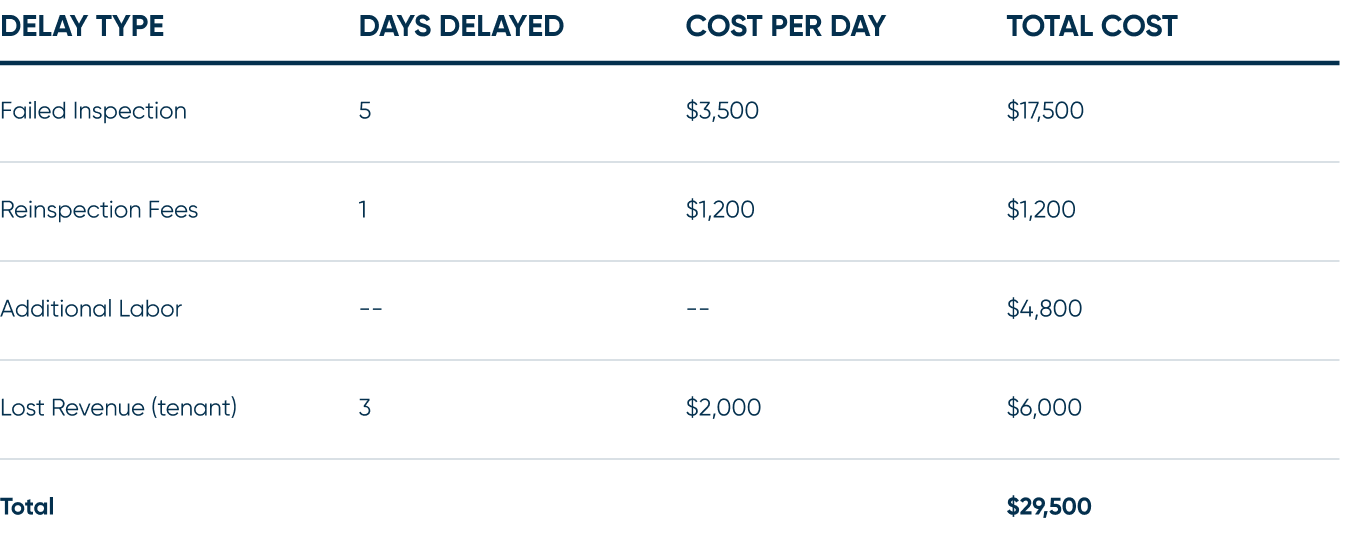5 MIN READ
The Fire Safety Cost Playbook: What You’ll Pay for Delays (and How to Cut Costs)
Posted on May 20, 2025
In construction and facilities management, everyone agrees fire safety is important, but at times, it slips down the list. Delays in fire safety planning and execution don’t just create stress—they create costs. Direct costs. Hidden costs. Regulatory costs. Relationship costs.
This playbook breaks down those costs and offers tactical strategies to eliminate them.
Part I: What Delays Actually Cost You
1. Reinspection Fees and Fines
Every failed fire safety inspection comes with a price tag. Reinspection fees add up quickly, and some jurisdictions charge thousands per visit. That’s before you factor in penalties for violations. For larger commercial spaces, fines can reach $20,000 per day.
Real cost: Reinspection + violation fine + staff overtime + rescheduling logistics.
2. Change Orders
Push fire safety to the end of a project, and you’ll pay for it through change orders. These are the industry’s equivalent of late fees. When safety systems need to be retrofitted or re-routed around finished work, labor and materials double.
Red flag phrases: “We didn’t budget for this.” “We’ll figure it out on-site.”
3. Project Delays
Construction lives and dies on the schedule. Fire inspections are often tied to final occupancy, meaning if they don’t pass, no one moves in. That stalls billing cycles, lease starts, and revenue recognition.
Bottom line: Days lost = dollars lost.
4. Downtime During Operations
For existing buildings, delayed inspections can force unscheduled shutdowns. This is the business equivalent of a pulled fire alarm in the middle of lunch service. Productivity tanks, employee frustration rises, and clients notice.
5. Reputation Damage
If your building fails inspection twice, the fire marshal remembers. If your GC reputation involves delays, word spreads. Vendors who miss deadlines affect your credibility. Poor fire safety planning echoes beyond the current project.
Hidden impact: Lost future bids. Strained client trust. Last-minute contractor switchouts.
Part II: Where the Delays Start
1. Last-Minute Vendor Engagement
Waiting until the last phase of construction to involve fire safety is like hiring a chef after the wedding invitations go out. Fire safety isn’t plug-and-play. Every day it’s delayed on the front end increases complexity on the back.
Your to-do: Loop in fire safety pros during early design and schedule phases.
2. Incomplete or Outdated Drawings
A fire safety plan based on old blueprints is a trap. Whether it’s walls moved, equipment relocated, or systems upgraded, inaccurate drawings lead to misalignment—and failed inspections.
Solution: Verify site conditions before your first submittal.
3. Vendor Silos and Scheduling Chaos
If alarms are handled by Vendor A, sprinklers by Vendor B, and inspections by Vendor C, delays multiply. Schedules don’t align. Communications get dropped. Issues fall through the cracks.
Better approach: One vendor. One calendar. One point of accountability.
4. Poor Communication
Nothing stalls a project like unanswered emails and vague timelines. Without proactive check-ins and clearly defined expectations, even small issues snowball.
Fix: Demand communication SLAs in your contracts. Track vendor responsiveness.
5. Playing the Waiting Game with Compliance
“We’ll worry about compliance if we get flagged.” That’s not a strategy. That’s gambling with your schedule, budget, and liability.
Reminder: Code violations aren’t suggestions. They’re shutdown triggers.
Part III: Strategies to Cut Costs and Stay Ahead
1. Use Fire Safety as a Planning Tool, Not a Panic Button
Start with fire safety. Don’t end with it. Fold inspections and system installations into the early project calendar. Review code updates before design begins. This saves time and avoids the domino effect of changes downstream.
Checklist:
- Add fire safety to pre-construction meetings
- Review past violations for the site
- Confirm timelines with the AHJ (Authority Having Jurisdiction)
2. Run a Vendor Cost-Benefit Audit
Cheapest vendor rarely means lowest cost. Run the numbers. Are change orders increasing? Are response times slow? Does your team spend more time managing them than executing your own job?
Scorecard Criteria:
- Response time
- Change order frequency
- Final cost vs. initial bid
- Inspection pass rate on first attempt
3. Get a Maintenance Plan
A recurring plan prevents recurring chaos. For operational buildings, set inspection reminders, pre-schedule visits, and use the same vendor who knows your systems. The goal is no surprises.
Bonus: Predictable spend = easier budget planning.
4. Build in Accountability
Add language in your contracts that ties performance to payment. Deadlines missed? Pay docked. On-time service? Bonus. It’s not just about punishment—it’s about prioritization.
Tool: Use milestone payments with clear fire safety deliverables.
5. Keep Documentation Tight
Keep digital, centralized records of past inspections, permits, vendor quotes, and system specs. During an inspection, “Let me find that” can quickly become “We failed.”
Suggested stack:
- Shared drive or digital binder
- Date-stamped inspection reports
- Service logs and technician notes
Part IV: Planning Templates and Tools*
Sample Budget Overrun from Delay

Pre-Inspection Timeline Sample
- Week 1: Vendor selection and scope definition
- Week 2: Site walkthrough with fire safety lead
- Week 3: Pre-inspection checklist completion
- Week 4: Schedule inspection with AHJ
- Week 5: Buffer for adjustments/fixes
- Week 6: Formal inspection
*This content is a sample and does not reflect real events, pricing, or actual client data.
Fire Safety Planning Pays Off
Fire safety doesn’t have to be a burden—it can be a strategic advantage. When addressed early, it becomes a predictable, manageable part of the project rather than a disruptive surprise. The reality is, most delays and budget overruns tied to fire safety aren’t the result of complex codes or impossible standards. They stem from timing—starting too late, looping in the wrong vendors, or relying on guesswork instead of clarity.
Teams that prioritize fire safety from the outset gain more than just compliance. They protect timelines, build stronger relationships with inspectors, reduce stress for stakeholders, and eliminate the need for costly fixes under pressure. A proactive approach doesn’t just prevent problems—it creates momentum. It helps you finish on schedule, avoid rework, and walk into inspections with confidence instead of crossed fingers.
At the end of the day, you’re already investing in fire safety. Investing earlier means you control that cost, rather than letting it control you. When you plan ahead, you don’t just stay compliant—you stay in control.


